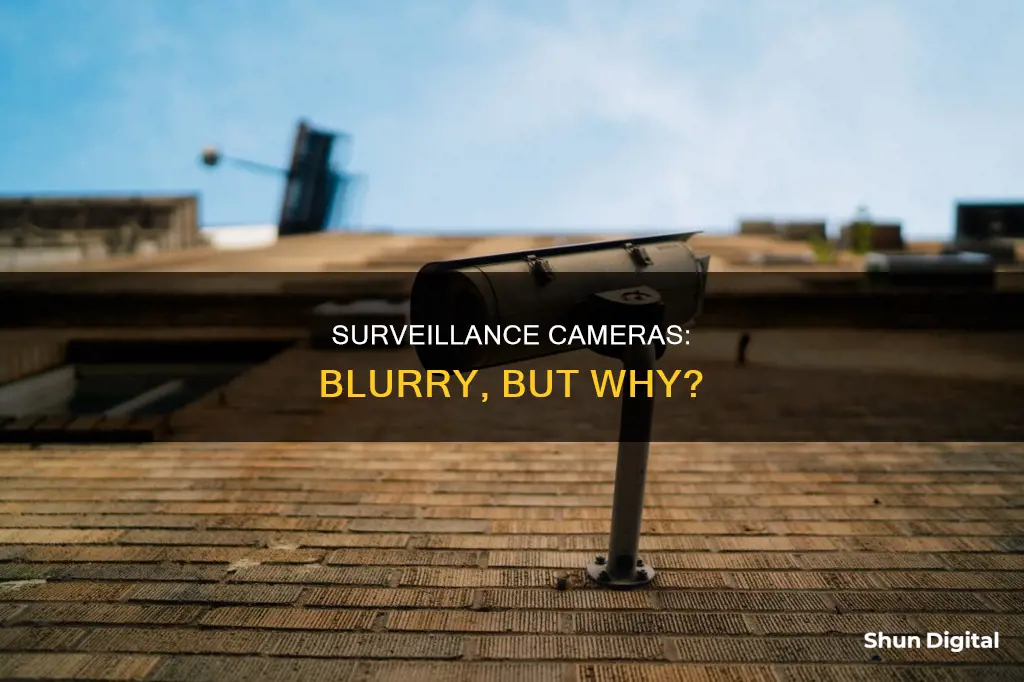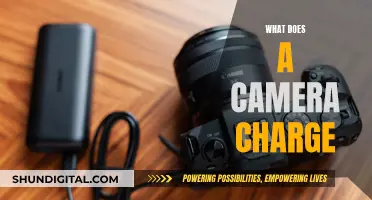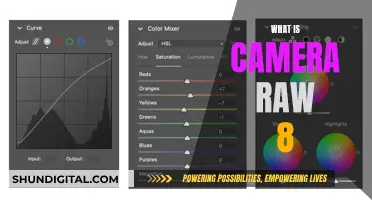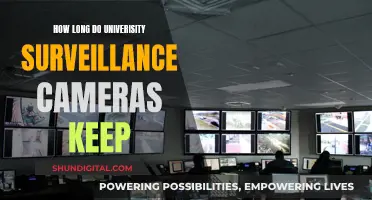
Surveillance cameras are often blurry due to a variety of reasons. One of the most common issues is that the lens is out of focus, which can be adjusted using the screws on varifocal lenses. Fixed-focus lenses, however, cannot be adjusted and rely on sufficient depth of field to produce a sharp image. External factors such as dust, dirt, and spider webs can also cause blurry footage, requiring regular maintenance and cleaning. In addition, the quality of the video cable and its length can impact image quality, with longer cables being more prone to damage and signal degradation. Furthermore, issues with firmware, camera settings, and low-resolution cameras can also contribute to blurry footage.
| Characteristics | Values |
|---|---|
| Lens focus | Varifocal lenses can be adjusted using a screw; fixed-focus lenses cannot be adjusted |
| Dirt and dust | Buildup on the lens can cause blurry footage, especially when the camera is exposed to rain |
| Spider webs | Spiders often build webs on surveillance cameras, which can be removed with a lens cloth |
| Cable length | Longer cables deteriorate image quality and are more prone to damage |
| Cable quality | Using copper-clad aluminium instead of copper for video cables can affect footage quality |
| Camera settings | Adjusting the contrast and brightness may improve image quality |
| Firmware | Technical issues or bugs in the firmware can cause blurriness |
| Lighting conditions | Security cameras often produce lower-quality footage at night or in low-light conditions |
| Camera resolution | Low-resolution cameras produce blurrier footage compared to high-definition cameras |
What You'll Learn

The lens is out of focus
If you are experiencing issues with blurry footage from your security camera, it could be that the lens is out of focus. This is a common issue with security cameras, and there are a few things you can try to fix it.
First, check what type of lens your camera has. If it is a varifocal lens, you should be able to adjust the focus by turning a small screw on the lens. You can do this by viewing the footage on a monitor or smartphone and adjusting until the image is clear. If you are using a smartphone, you can also adjust the focus through your phone's app or by going to PTZ (pan, tilt, zoom) and hitting the focus button.
If your camera has autofocus, it should be able to focus automatically. However, if the autofocus is not working, you can try adjusting the focus through your smartphone or through the PTZ settings, as mentioned above.
Some security cameras have fixed-focus lenses, which cannot be adjusted. In this case, you need to ensure the camera is set at the correct distance to stay in focus. It is also important to keep the lens clean and free of dirt and dust, as this can impact the image quality.
If you have tried these steps and are still experiencing blurry footage, there may be another issue with your camera. Other potential causes of blurry footage include low resolution, loose video connectors, or a defective image sensor.
The Raw Camera Filter: Where Did It Go?
You may want to see also

The lens is dirty
One of the most common issues with security cameras is blurry footage. This can be caused by a variety of factors, one of which is a dirty lens. Dirt and dust buildup can lead to blurry footage, especially during the rainy season when the camera gets dirty and wet. Foreign particles on the lens can obstruct the camera's ability to capture clear images, resulting in a hazy or cloudy output.
To address this issue, it is important to regularly clean the camera lens. This can be done by using a microfiber cloth to gently wipe the lens. It is recommended to spray the lens with water before wiping it to ensure effective cleaning without scratching the lens. For cameras installed out of reach, an extension pole or broomstick with a microfiber cloth wrapped around the end can be used to remove dirt and dust.
It is advised to clean the security camera lens at least once every four months to prevent excessive dust and dirt buildup, ensuring clear and sharp video quality. However, during the rainy season or in dusty environments, more frequent cleaning may be required.
In addition to cleaning, it is also crucial to protect the camera lens from further dirt and dust accumulation. This can be achieved by installing a protective cover or housing for the camera, which can prevent foreign particles from directly landing on the lens. Additionally, regular maintenance and inspection of the camera can help identify any dirt buildup and allow for prompt cleaning.
By maintaining a clean lens and providing adequate protection, you can significantly reduce the chances of blurry footage caused by a dirty lens and ensure optimal performance from your security cameras.
Surveillance Cameras: Do They Need Wi-Fi to Work?
You may want to see also

The cable is too long
While there are many reasons why security camera footage may be blurry, one factor that is often neglected is the quality and length of the cable. The cable is a crucial component of a CCTV system, carrying power to the cameras and transmitting video signals back to the monitoring station or DVR.
The length of the cable can impact the quality of the video signal, and thus affect the clarity of the footage. Longer cables may result in a degradation of the signal, leading to blurry or fuzzy images. This is especially true if the cable is of inferior quality or is improperly installed.
There are various types of cables available for CCTV installations, such as RG59 coax cable and UTP cable (CAT-5). The maximum recommended length for RG59 coax cable is 700-800 feet, while UTP cable with passive video balun can reach up to 1,200 feet. If longer distances are required, the use of CCTV video amplifiers or active/powered video baluns can extend the range.
It is important to select the appropriate cable for your CCTV system and to ensure proper installation. A high-quality cable with a good copper shield, sufficient braid density, and a solid center conductor will help to reduce electromagnetic interference and maintain clear video signals.
Additionally, voltage drop, which is a reduction in voltage over distance, can be more pronounced with longer cables, particularly if the cable has a lower number of strands or inferior conductive quality. This can lead to distortion or a complete loss of the video signal.
Therefore, when selecting a cable for your surveillance system, it is crucial to consider the length and choose a cable that meets the required specifications to ensure optimal video quality.
The Evolution of First Disposable Camera
You may want to see also

The camera has poor resolution
The resolution of a camera refers to the amount of detail it can capture. The higher the resolution, the more detailed the resulting videos and images will be. Modern security cameras have resolutions of 2MP (1080p), 4MP (1440p), 5MP (1920p), and 8MP (4K/2160p). If a security camera has a resolution lower than these numbers, it will likely produce blurry footage.
The low resolution of surveillance cameras is often a result of cost constraints. State-of-the-art security systems can be extremely expensive, especially when multiple cameras are required. For large companies or government bodies, the cost of purchasing and maintaining high-end equipment for every camera can be prohibitive.
Additionally, the massive amount of data generated by high-resolution cameras can be challenging to store. A single basic camera recording continuously for a day can produce approximately 1Tb of data. When this is scaled up to dozens or hundreds of cameras, the storage requirements become immense. As such, many organisations opt to delete footage after a few days to manage storage space. However, this can be a problem if an incident occurs and the footage is needed after the deletion period.
To address the issue of poor resolution, organisations may need to allocate more resources towards their security systems. This could involve investing in higher-resolution cameras, as well as additional storage capacity. By utilising modern camera technology and efficient data storage solutions, it is possible to significantly improve the quality of surveillance footage.
In some cases, the issue of poor resolution may be exacerbated by other factors. For example, the placement of the camera or lighting conditions can affect the clarity of the footage. Ensuring that cameras are positioned optimally and are equipped with suitable lighting features, such as infrared technology, can enhance the effectiveness of the security system.
Upgrading to higher-resolution cameras can bring several benefits. In addition to improved image quality, high-resolution cameras can provide a wider field of view, capturing more detail in a single shot. This can be particularly useful in surveillance applications, where capturing a broad area is often necessary.
Capturing Sports Action: Keeping Your Camera in Sports Mode
You may want to see also

The camera has a fixed lens
One of the primary reasons why surveillance cameras produce blurry images is the use of fixed lenses. Fixed lenses have a predetermined focal length, which means that the camera's focus is set to a specific distance. This design is in contrast to varifocal or zoom lenses, which offer adjustable focal lengths. While fixed lenses provide advantages in terms of cost and simplicity, they can also be a significant contributing factor to blurry surveillance footage.
The use of a fixed lens means that the camera's focus is locked at a certain distance, typically designed to capture objects within a specific range. If an object moves closer or farther away from this preset distance, it will quickly move out of the camera's depth of field, resulting in blurred images. This limitation can be particularly problematic for surveillance cameras that need to capture subjects at varying distances, such as in busy public spaces or areas with frequent foot traffic.
Another issue with fixed lenses is their inherent limitation in capturing fine details. Unlike varifocal lenses, which allow for adjustments to enhance focus and clarity, fixed lenses provide a static field of view. This means that if the camera is not properly positioned or angled to capture the specific area of interest, important details may be missed, or the footage may appear blurry or unclear. Proper installation and positioning of the camera are crucial to mitigate this issue.
In addition, the quality of the fixed lens itself plays a significant role in the clarity of the surveillance footage. Lower-quality lenses may introduce optical aberrations, such as chromatic aberration or distortion, which can degrade image quality and introduce blurriness. Cheap lenses may also have lower contrast and sharpness, impacting the overall clarity of the captured images. Investing in higher-quality lenses can help mitigate these issues and improve the overall performance of the surveillance system.
It is important to note that the use of fixed lenses in surveillance cameras is often a trade-off between cost and performance. Fixed lenses are more economical and easier to produce, which makes them attractive for mass-market surveillance equipment. However, for specialized applications or environments where image clarity and detail are critical, investing in cameras with varifocal or zoom lenses, along with higher-quality lens optics, may be necessary to overcome the limitations of fixed lenses and improve the overall effectiveness of the surveillance system.
Evernote Camera Mode: How to Switch and Use It
You may want to see also
Frequently asked questions
There are many reasons why surveillance cameras produce blurry footage. The lens might be out of focus, or the lens may be dirty. Water droplets on the glass dome can cause the light to reflect back into the lens, and the image sensor may be defective.
The camera might be a low-resolution camera, which will look blurry when compared to high-definition cameras. The length of the cable can also play a role in deteriorating image quality.
Problems with firmware, or a bug in the programming, can cause blurry images. The camera might also be set up incorrectly, so that it does not focus on the right objects.







